口译笔记符号.ppt
口译常用速记符号
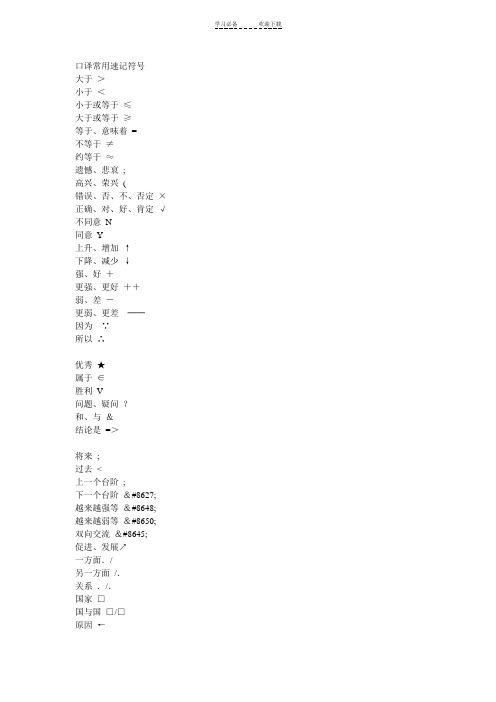
口译常用速记符号大于>小于<小于或等于≤大于或等于≥等于、意味着=不等于≠约等于≈遗憾、悲哀;高兴、荣兴(错误、否、不、否定×正确、对、好、肯定√不同意N同意Y上升、增加↑下降、减少↓强、好+更强、更好++弱、差-更弱、更差──因为∵所以∴优秀★属于∈胜利V问题、疑问?和、与&结论是=>将来;过去<上一个台阶;下一个台阶&#8627; 越来越强等&#8648; 越来越弱等&#8650; 双向交流&#8645;促进、发展↗一方面./另一方面/.关系./.国家□国与国□/□原因←导致、结果→对立、冲突><波折<<会议、会面⊙进入∩接触、交往∞分歧⊥非常、十分重要**坚持≡关键!奇观!有关@替换为∽但是∥与……比较而言∥空洞○代表△口译成功与否在很大程度上取决于译员在口译表达前对感知的信息进行记录的能力。
记录分为“脑记”和“笔记”两种。
人脑的记忆由短时记忆和长时记忆两部分组成。
顾名思义,短时记忆是一种操作性的暂时记忆,长时记忆属于一种储存性的永久记忆。
影响一个人短时记忆的因素很多,其中最主要的因素是记忆内容的意义性。
即便是当感知的信息有意义时,人的短时记忆只可容纳由二十多个单词组成的句子,或者一组十位数的数字。
因此,对于口译工作者来说,完全依赖人脑的记忆能力是危险的,记笔记便显得十分重要。
做口译笔记时的注意事项1.口译笔记应记要点,切忌求记“全”。
口译笔记是记忆的延伸或补充,不应也不必取代记忆。
口译笔记的主要内容是概念、命题、名称、数字、组织机构和逻辑关系(如大小、先后、正反、上下、升降、因果关系等),笔记单位以表达意群的词语和符号为主。
2.口译笔记求快求精,但不可潦草。
3.口译笔记可使用来源语,也可使用目标语,也可以双语兼用。
只要有利于口译的准确性和流利性,不必拘泥于某种文字或符号。
例如,“联合国大会”可笔录为“UN”或“联大”。
4.口译笔记使用大量常见略语,例如:cf(compare), Co(company), eg(for example), etc(and so on), esp(especially), ie(that is), max(maximum), min(minimum), ref(reference), std(standard), usu(usually),等。
口译笔记符号
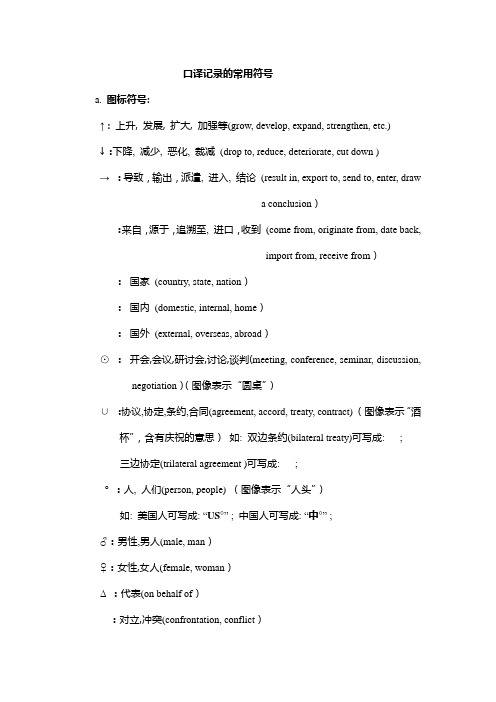
口译记录的常用符号a.图标符号:↑ : 上升, 发展, 扩大, 加强等(grow, develop, expand, strengthen, etc.)↓ :下降, 减少, 恶化, 裁减(drop to, reduce, deteriorate, cut down )→ :导致,输出,派遣, 进入, 结论(result in, export to, send to, enter, drawa conclusion):来自,源于,追溯至, 进口,收到(come from, originate from, date back,import from, receive from):国家(country, state, nation):国内(domestic, internal, home):国外(external, overseas, abroad)⊙:开会,会议,研讨会,讨论,谈判(meeting, conference, seminar, discussion, negotiation)(图像表示“圆桌”)∪:协议,协定,条约,合同(agreement, accord, treaty, contract) (图像表示“酒杯”,含有庆祝的意思)如: 双边条约(bilateral treaty)可写成: ;三边协定(trilateral agreement )可写成: ;°:人, 人们(person, people) (图像表示“人头”)如: 美国人可写成: “US°” ; 中国人可写成: “中°” ;♂:男性,男人(male, man)♀:女性,女人(female, woman)Δ:代表(on behalf of):对立,冲突(confrontation, conflict)~ :交流,交换, 相互(exchange, replace, each other)?:疑问,问题,提问(doubt , problem, question, ask): :说,告诉,认为,声明,例如(say, speak, tell, think, declare, such as, like)( ):包括,在…之中/内,封闭(including, within, among, inside, seclusion)∈:属于,归于,归属(belong to ,be part of, fall into, pertain to)// :停顿,停止,终止(stop, halt)& :和,与…一起(and, together with)…:等等(and so on, and so forth, and the like, etc.)√:正确,好,肯定的,积极的,同意(correct, good, affirmative, certain, positive, agree)×:不/非,错误的,坏的,不好的, 否定的(not, no, wrong, incorrect, bad, notorious, negative)☆:杰出的,优秀的,最佳的,重要的,榜样(outstanding, excellent, best, important, model)(星光璀璨,表示“优秀,突出”):高兴,开心,愉快,兴奋(happy, pleased, delightful, joyful, excited)(这是个脸谱图像符号,嘴巴向上翘,表示“开心”):不满,生气,不开心,郁闷(unsatisfied, angry, unhappy, gloomy)(嘴巴向下撇,表示“不高兴”):惊讶,惊奇,吃惊,震惊(surprised , astonished , amazed, shocked )(嘴巴张大,表示“吃惊”):害怕,恐惧,恐慌(scared , frightened, panic ) (两只眼睛张大,表示“恐惧”):听说,据说,众所周知(it is said that, maybe you’ve heard of, as we allknow , as is known to all ) (脑袋上画个耳朵,表示“听说过,有所闻”)b .数学符号:= :等于,相当于,是…的对手(equal to, the same as, a match/rival/competitor for sb.)≠:不等于,不同,不是…的对手(not equal to, different, no match for)≈:大约,左右(approximately, around, or so )>:大于,多于,超过,优于(greater, larger or more than, better than, surpass, superior to)<:小于,少于,不够,劣于,次于(smaller/fewer/less than, worse than, inferior to)+ :加上,另外,除此之外(plus, add, moreover, besides, in addition to, furthermore)-:减去,扣除,缺乏(minus, deduct, lack )∑:总共,合计(total, in all, add up )% :百分比,百分之…(percent)‰:千分比,千分之…(per thousand)∵:因为, 由于(as, because, owing to, due to, thanks to)∴:所以, 因此, 因而(consequently, so, therefore, as a result)c .常用缩写词:UN ( United Nations ) :联合国UNESCO (United Nations Educational, Scientific and Cultural Organization):联合国教科文组织UNICEF (United Nations International Children's Emergency Fund):联合国儿童基金会UNHCR (United Nations High Commissioner for Refugees):联合国难民公署EU (European Union ) : 欧洲联盟(简称“欧盟”)EEC (European Economic Community): 欧洲经济共同体NATO (North Atlantic Treaty Organization): 北大西洋公约组织APEC (Asian Pacific Economic Cooperation): 亚太经济合作组织WTO (World Trade Organization): 世界贸易组织WB (World Bank): 世界银行IMF(International Monetary Fund):国际货币基金组织L.G( ladies and gentlemen):女士们、先生们TKS( thanks):谢谢Org(organization):组织Co.(Company):公司MKT(market):市场L/C(letter of credit):信用证Ltd.(Limited): 有限Memo (memorandum): 备忘录 B.C.(before Christ): 公元前e. g. (for example): 例如i.e. (that is ): 即;那就是etc. (and so on ):等等esp.(especially):特别;尤其usu.(usually):通常;惯常max.(maximum): 最高min.(minimum): 最低;最小Wt.(weight):重量Kg.(kilogramme):公斤;千克b. (billion ): 十亿m.(million, meter, mile):百万;米;英里t.( thousand ,temperature , ton):千; 温度; 吨h. (hundred, hour, height): 百;小时;高度km. (kilometer)千米:公里sq. km (square kilometer):平方公里E(East):东S( South):南W( West ):西N( North ):北Q.( question ) :问题; A.(answer, acre ): 回答;英亩C (centigrade): 摄氏温度F( Fahrenheit): 华氏温度att. (attention):注意cf.(compare):比较c/o(care of): 转交ref.(reference):参考add.(Address):住址st.(street): 街std.(standard): 标准econ. (economy):经济ad.(advertisement):广告w (world):世界p (peace):和平r (repetition):重复y (year):年m (month):月w (week):星期 d (day):日a.m.(before noon):上午p.m.(afternoon):下午CN(China):中国(或简写为“中”) US(United States ):美国F(France):法国J(Japan):日本(或简写为“日”) UK(United Kingdom):英国HK(Hong Kong):香港MO(Macao):澳门TW(Taiwan):台湾AL(Australia ):澳大利亚SD(Sweden):瑞典SZ(Switzerland):瑞士CIS (Commonwealth of Independent States):独联体IQ(Iraq):伊拉克IR(Iran):伊朗ID(India):印度IN(Indonesia):印度尼西亚PL(Palestine ):巴勒斯坦PK(Pakistan):巴基斯坦d .综合性符号:. d ( yesterday): 昨天.. d (the day before yesterday): 前天. y( last year): 去年.. y (the year before last ): 前年d . (tomorrow): 明天 d .. (the day after tomorrow): 后天y . (next year): 明年y .. (the year after last): 后天[注:在年、月、日缩写词前后加“.” , 表示时间的推前或后移。
口译笔记常用符号

常用符号(一)数学符号+表示“加上”、“另外”、“除此之外”or“多”(plus, and, in addition to 或者many, lots of, a great deal of, a good many of, etc.)++(+2) 表示“多”的比较级:more+3 表示“多”的最高级:most-表示“减去”or “缺乏/少”(minus, lack, in short of/ in shortage of etc或者little, few)×表示“错误”、“失误”和“坏”的概念(wrong/incorrect,something bad,notorious,negative, etc.)√表示“对的”、“好的”、“积极的”(correct, good, positive, affirmative)> 表示“多于”或者“超过”(bigger/larger/greater/more than/better than, surpass, superior to, etc.)< 表示“少于”或者“不如”、“逊色”(less/smaller/fewer than, worse than, inferior to, etc.)≥表示“大于或等于”、“不少于”(more than or equal to, no less than)≤表示“小于或等于”、“不多于”(less than or equal to, no more than)= 表示“同等”、“相当于”(means,that is to say,in other words,the same as,be equal to, etc.) 也表示“对手”概念(a match, rival, competitor, counterpart, etc.)≠表示“不同”概念(be different from, etc. )表示“无敌”概念(matchless, peerless, etc.)≈表示“大约”概念(about/around,approximately, or so,etc.)Є表示“属于”(belong to)( ) 表示“在......之间”(among, within, etc. )( 和)都可以表示并列/ 表示“否定”,“消除”等概念(cross out, eliminate, etc.)∵“由于”、“因为”、“幸亏”(because, due to, thanks to, as, owing to)∴“所以”、“因此”、“结果是”(so, therefore, as a result, consequently)⊥表示“在……基础上”(based on),或者“影响”、“效果”、“压力”“负担”(influence, effect, impact, pressure, stress, burden, load)E 数学符号表示总值(total, totally, entire, entirely, on the whole, all in all, to sum up, ect. )(二)标点符号: 表示各种各样“说”或“想”的动词:say, speak, talk, marks, announce, declare, express, think, etc. 表示“问题”或“疑问”:question,issue,doubt例如:台湾问题:tw? 也可表示“问”(ask)·(dot) 这个“·”点的位置不同表示的概念也不一样“·d”表示yes terday, “·y”表示last year, “·2m”表示two mo nths ago。
(完整版)口译笔记常用符号
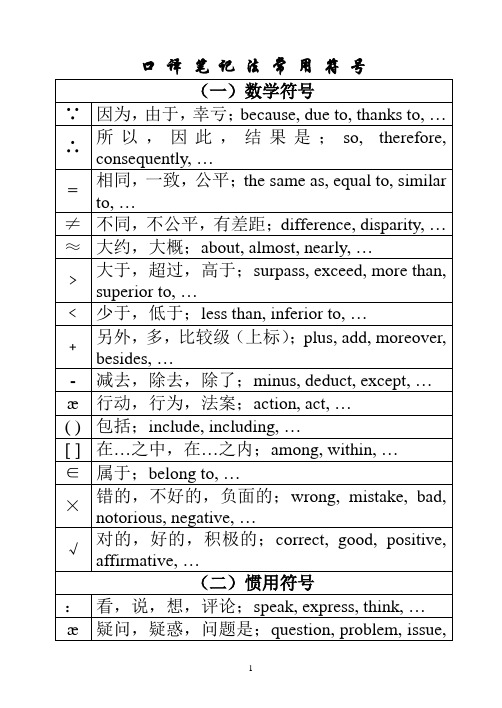
口译笔记法常用符号inquiry, interrogate, ask, mystery,…问题;question, problem, …!危险,警告,当心,值得注意的是;dangerous, warning, alarm, watch out, of course°人,人民,伙伴,朋友;people, partner, …✉信息,消息,情报;information, message, intelligence, …删除,废除,放弃;delete, discard, give up, …ഗ贸易,交换,交流,关于,关联,替代;trade, exchange, communication, relationship__ 这个,强调;emphasize a certain word/ phrase.…继续,持续,不断的,长期的,各种各样的,多的;more, continuous, …=> 加强,推动,促进;enhance, promote, …×#不仅;not only, …& 和,而且;and…@关于;aboute.g.例如,比如;for example, such as, …(三)图形符号☺高兴,激动;happy, pleased, excited, …☹失望,不满意,生气;unhappy, unsatisfied, angry, …会议,聚会;conference, symposium, convention, session, forum, seminar, council, congress, meeting, assembly, gathering, committee,commission, association, union, senate, parliament, convocation, …学校,大学,教育机构;school, college, educational institution, …医院,医疗机构;hospital, medical institution, …○全部的,整个的,所有的,完整的,彻底的;complete, whole, …目标,目的;aim, objective, target, …ര看到,注意到;see, notice, watch, …ര重视,强调;pay attention to, highlight, …□国家,民族;nation, state, republic, kingdom, federal, union, …国际,世界;international, world, …∧领导,顶点,顶级,最高级(上标);top, peak, leader, boss, king, governor, mayor,…国家领导人,政府首脑;state leader, …出口;export, …进口;import, …△城市,都市;city, urban, metropolitan, cosmopolitan, …▽农村,乡村;village, rural, country, countryside, farm, suburb, outskirt, …☆重点,重心,重视,重要的,主要的,杰出的;important, significant, remarkable* 特征,特点,代表;feature, characteristic, quality, nature, trademark, on behalf of…♀女性;woman, female, …♂男性;man, male, …V 胜利,凯旋;victory, triumph, …﹩美元,钱;有钱的,富裕的;dollar, money, rich, well-off, …∪协议,决议,合约,条约;agreement, treaty, contract, compact, convention resolution结束,停止,完成,实现;halt, stop, complete, …‖渠道;channel, tunnel, tube, pipe, ditch, duct, …发展;development, advancement, …开放;opening, …∟过去;in the past, long before, past time, …∟将来;in future, in the future, …↓影响,效果,压力,负担;influence, effect, affect, pressure, stress, burden, load,…(四)趋向符号←邀请,需要,访问,来到;be invited, needed, come (here), …→去,到,走;to, go (there)…↑增加,提升,提高,升级,升值;increase, improve, enhance, grow, lift, promote…↓减少,下降,降低,贬值;decline, decrease, reduce, degrade, lower, diminish, …(五)英文字母y 年;year M 月;month改编自吴钟明. 《英语口译笔记法实战指导》.武汉大学出版社。
口译用的速记符号

常用速记符号大于>小于<小于或等于≤大于或等于≥等于、意味着= 不等于≠约等于≈遗憾、悲哀; 高兴、荣兴( 错误、否、不、否定×正确、对、好、肯定√不同意N 同意Y 上升、增加↑下降、减少↓强、好+更强、更好++弱、差-更弱、更差――因为∵所以∴优秀★属于↔胜利V 问题、疑问?和、与&结论是=>将来; 过去< 促进、发展↗一方面·/ 另一方面/·关系·/·原因←导致、结果→对立、冲突>< 波折<<会议、会面⊙进入∩接触、交往∞分歧⊥非常、十分重要** 坚持≡关键!奇观! 有关@ 替换为∽但是‖与……比较而言∥空洞○代表△口译成功与否在很大程度上取决于译员在口译表达前对感知的信息进行记录的能力。
记录分为“脑记”和“笔记”两种。
人脑的记忆由短时记忆和长时记忆两部分组成。
顾名思义,短时记忆是一种操作性的暂时记忆,长时记忆属于一种储存性的永久记忆。
影响一个人短时记忆的因素很多,其中最主要的因素是记忆内容的意义性。
做口译笔记时的注意事项1.口译笔记应记要点,切忌求记“全”。
口译笔记是记忆的延伸或补充,不应也不必取代记忆。
口译笔记的主要内容是概念、命题、名称、数字、组织机构和逻辑关系(如大小、先后、正反、上下、升降、因果关系等),笔记单位以表达意群的词语和符号为主。
2.口译笔记求快求精,但不可潦草。
3.口译笔记可使用来源语,也可使用目标语,也可以双语兼用。
只要有利于口译的准确性和流利性,不必拘泥于某种文字或符号。
例如,“联合国大会”可笔录为“UN”或“联大”。
4.口译笔记使用大量常见略语,例如:cf(compare), Co(company), eg(for example), etc(and so on), es p(especially), ie(that is), max(maximum), min(minimum), ref(reference), std(standard), usu(usually),等。
英语学习_英语口译笔记符号

w/o without
速记样例
• (1) As an American manager of a SinoAmerican joint venture for two years, I have to say that there are differences in business management between Chinese and Americans. // We are more direct and straightforward than most Chinese colleagues due to our different cultural traditions. // 美 经 中美合企 2年 I 说 dif@bus. man. 中← →美// we 更 直 率 比 中←不同文传//
• ass. assistant/ association
co. deg company degree
dist distance/ distinguish ed. IVO Education/ editor in view of
econ economics/ economy ins nr insurance near
速记训练 • I’m very glad to have the opportunity to work in your company , and I am particularly pleased to be able to work with a group of distinguished people in China’s automobile industry. / / I had been looking forward to this job for many years and you have made my dream come true. / / I’m deeply grateful to you and appreciate all you have done for me , especially the new residence by the beach that you have chosen for me. / / If you don’ mind, I wish to tour around your company properties and meet my Chinese colleagues and lab assistants tomorrow. •
口译笔记 图例和符号(大字版)
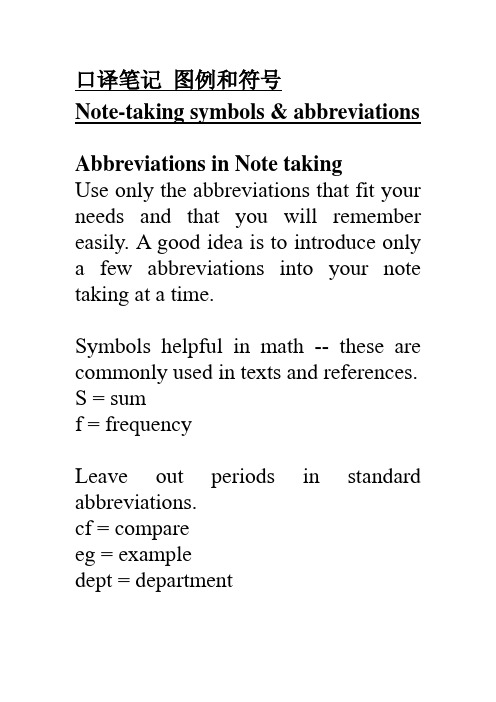
口译笔记图例和符号Note-taking symbols & abbreviations Abbreviations in Note takingUse only the abbreviations that fit your needs and that you will remember easily. A good idea is to introduce only a few abbreviations into your note taking at a time.Symbols helpful in math -- these are commonly used in texts and references. S = sumf = frequencyLeave out periods in standard abbreviations.cf = compareeg = exampledept = departmentUse only the first syllable of a word. pol = politicsdem = democracylib = liberalcap = capitalismUse entire first syllable and only 1st letter of 2nd syllable.pres = presentationsubj = subjectind = individualcons = conservativeEliminate final letters. Use just enough of the word to form a recognizable abbreviation.assoc = associatebio. = biologyinfo = informationach = achievementchem = chemistrymax = maximumintro = introductionconc = concentrationmin = minimumrep = repetitionOmit vowels, retain only enough consonants to give a recognizable skeleton of the word.ppd = preparedprblm = problemestmt = estimatebkgd = backgroundgvt = governmentUse an apostrophe in place of letters. am’t = amountcont’d = continuedgov’t = governmenteducat’l = educationalForm the plural of a symbol or abbreviated word by adding s.chpts = chaptersegs = examplesfs = frequenciesintros = introductionsUse g to represent ing endings.ckg = checkingestg = establishingdecrg = decreasingexptg = experimentingIf a term, phrase, or name is written out in full during the lecture, substitute initials whenever the term, phrase, or name is used again.CAS = Center for Aerospace Sciences Use symbols for commonly recurring connective or transitional words.& = andw = withw/o = withoutvs = against\ = therefore= = is / equalUse technical symbols where applicable.ibid = Latin, the same worko = degreesH2O = waterUse standard maths, accounting, and science symbols.+ plus// parallelUse standard abbreviations and leave out full stops.eg exampleIT Information TechnologyUK United KingdomUse only the first syllable of a word.Mar=marketingCus= customerCli=clientUse the entire first syllable and the first letter of the second syllable. Subj= subjectBudg= budgetInd= individualTo distinguish among various forms of the same word, use the first syllable of the word, an apostrophe, and the ending of the word.tech'gy=technologygen'ion=generalisationdel'y=deliveryUse just enough of the beginning of a word to form a recognisable abbreviation.Assoc= associatedAch= achievementInfo=informationOmit vowels from the middle of words, retaining only enough consonants to provide a recognisable skeleton of the word.Bkgd=backgroundMvmt=movementPrblm= problemForm the plural of a symbol or abbreviated word by adding 's.' Custs= customersFs= frequenciesUse 'g' to represent 'ing' endings. Decrg= decreasingCkg= checkingEstblg= establishingLeave out unnecessary articles.a an theIf a term, phrase, or name is initially written out in full during the talk or meeting, initials can be substituted whenever the term, phrase, or name is used again.JACB= January Advertising Campaign BudgetUse symbols for common connective or transition words.@ =at 2=to4=for &=andvs= againstCreate your own set of abbreviations and symbols. You may wish to develop separate sets of symbols and abbreviations for different courses or subjects.Other Symbols and Abbreviations<---> as a result of / consequences of ---> resulting in+ and / also= equal to / same asff following* most importantly< less than> greater thanEsp. especially字母、图像人people/person,日本人:日人P 政治,politics, politicalE 总数,total, totally, entire, entirely, on the whole, all in all, to sum up, etc. G效率:efficient, effectiveQ“通货膨胀”:inflationA农业: agriculture. agricultureB商业:businessC×冲突,矛盾conflict,confrontation W工作,职业: work, employi工业: industry, industrialU U 看酷似一个酒杯,在笔记中表示合同、协议(treaty, agreement)一般只有在谈判成功、协议成交后才会表示“举杯祝贺”。
口译笔记常用符号及缩略语-new
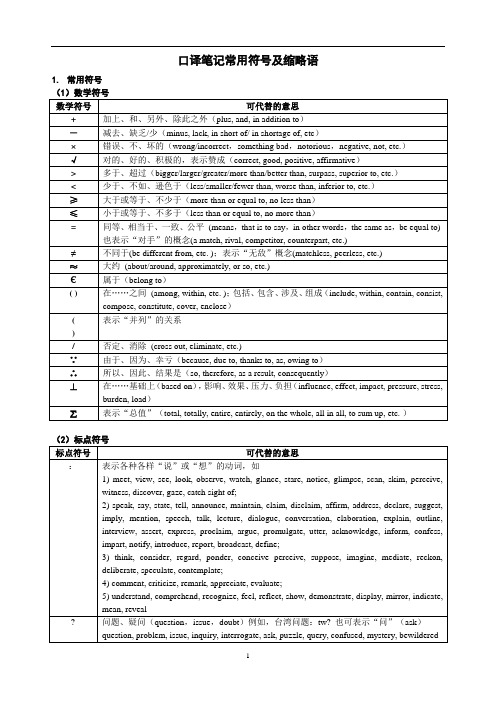
因形状看起来像酒杯,表示值得庆祝的“协议”、“协定”、“条约”或“合同”(agreement, accord, treaty, contract)。因此,“双边协议”、“三边协议”或者“多边协议”就可以分别在∪里面加上2、3或者m(多)。
$
表示“金钱”、“财富”(money, wealth)
∞
交流、交换、关系、相互的(communication, relationship, relation, partnership, interrelation, communicate, exchange, interchange, interact, each other)
˚
表示“人”(person, people),因为它看起来像个人头。一般不单独用,而是用在单词、符号或者字母的右上角,比如“中国人”可以写成“中˚”,“美国人”(US˚),“政客/政治家”(政˚),“老师”(T˚或者教˚)
因为看起来像圆形的会议桌,所以常用来表示“会议、开会、讨论或谈判”等,或者会议性的机构。
口译笔记常用符号及缩略语
1.常用符号
(1)数学符号
数学符号
可代替的意思
+
加上、和、另外、除此之外(plus, and, inadditionto)
-
减去、缺乏/少(minus, lack,in short of/ in shortage of,etc)
×
错误、不、坏的(wrong/incorrect,something bad,notorious,negative,not,etc.)
加在动词下表示“过去的动作”、“……过”或“……了”;加在表示时间的数字下面表示“过去……年/月天(last, past)”
∧
口译笔记法ppt课件

口译笔记要点
1. 少写多划。划线条比写文字快。线条形象,相当于翻译的"半成品",有助译员眼看笔记,口出译文。两种情况下应该尽量用线条: 表示动作和动态的词句。比如,以上升的斜线代表"发展","增加","进步","进一步";以下降的斜线代表"减少","下降","恶化"等等。 表示因果或前后关系的词句。比如,用一条线代表"因为/所以","…之后","在…之前",以体现出上下前后之间的关联关系。
沛棠陶连琉味粹骚丙炸匿怠饺汾需降芥才辨惶距螟戏梦秘四青稠蠕奔卷歼口译笔记法ppt课件口译笔记法ppt课件
笔记是高级口译的关键。使用笔记,是为了补充大脑短期记忆和耐久力的不足,以保证译文的精确度,并保证其不受讲话人持续时间的影响。 如果完全依赖记忆,又没有异常的天赋,即使精力充沛的年青人,也不能胜任高级口译对精确度和耐久力的要求。高级口译员没有不靠笔记的。但是,高级口译使用的笔记与一般的概念,风马牛不相及。
4. 少横多竖。采取从上往下的阶梯结构记录,尽量少用通常书写时的横向记录。阶梯结构形象地体现出上下文的逻辑结构,简化了译员的思维过程,方便出译文。
心伦艇棚孽马俯工值明航拙煽写掘阁氢珍蝎女货滩岗衔磋能驾蜒凯智嚎幂口译笔记法ppt课件口译笔记法ppt课件
5. 快速书写。必须发展自己的汉字快速书写系统。口译笔记完全是自己看,而且只需要几分钟之内能看懂就行。很多汉字笔划减少后,并不影响确认。我这里讲的不是潦草,而是除了实际口译经常不得不潦草之外,花一些时间,把练习中或口译工作中常用的字琢磨一下,看看可以怎样减少笔划,或理顺笔划,一笔成字。
口译笔记符号 ppt课件

远 近
far away near, close
PPT课件
20
台阶,进步 step by step, progress, advance make progress
过去, 历史 in the past, history 昨天 yesterday 上个月 last month 去年 last year
2. 关系 interaction, relation, relationship partnership
PPT课件 15
双边关系,bilateral relationship 多边关系,multilateral relationship
举杯,协议 toast, agreement, treaty, contract Convention, revolution
citizen, urban residents / inhabitants
famer, peasant, rancher, agriculturist universal, worldwide, international, transnational, global, transcontinental, all over the world, across boundaries
双边协议,bilateral agreement 多边协议,multilateral agreement
PPT课件
16
发展,develop, development
发达的,developed
发展中的,developing
⊕
1. 开始 begin, start, initiate, open, originate, launch, pioneer commence, inaugurate
《口译笔记符号》课件

口译笔记符号的使用是提高口译质量的关键,从时间和数量到同音替换,通 过本课件,您将学会各种符号的分类和用法示例。
口译笔记符号
符号分类
- 时间和数量 - 序号和级别 - 同音替换 - 简写和缩写 - 标点符号
用法示例
- 时间和数量 - 序号和级别 - 同音替换 - 简写和缩写 - 标点符号
使用符号记录同音替换的词语,例如将" 改变"替换为"改良"。
2 申请文件:深情文件
使用符号表示含有同音替换的词语,例如 将"申请"替换为"深情"。
简写和缩写
1 下午开会:pm开会
使用符号表示简写或缩写的词语,例如"下午"可以简写为"pm"。
2 部门名称:Dept.
使用符号表示部门名称的缩写,例如"Department"可以缩写为"Dept."。
标点符号
1 表示强调:!
使用符号表示标点符号的强调作用,例如使用感叹号"!"表示强调。
2 表示疑问:?
使用符号表示标点符号的疑问作用,例如使用问号"?"表示疑问。
时间和数量
1 工作时间:10h
使用符号记录工作时间的长度,例如10个小时。
2 价格:3000元
使用符号表示价格的数量,例如名第二:2
使用符号表示不同级别或序号,例如级别 一对应字母A。
使用符号表示排名的序号,例如排名第二 对应数字2。
同音替换
1 感受到改变:感受到改良
口译笔记常用符号图文课件

04
笔记符号练习与提高
笔记符号练习与提高 符号练习题
符号练习
符号解释
在口译笔记中,使用符号可以大大提高记 录速度和效率。以下是一些常用的符号练 习题,帮助你熟悉和掌握这些符号
对于每个练习题,给出符号的解释和用法 ,帮助你更好地理解这些符号的意义和用 法。
练习方法
符号示例
提供一些练习方法,如重复练习、计时练 习等,帮助你提高使用这些符号的熟练度 和准确性。
时间符号使用注意事项
在此添加您的文本16字
注意区分罗马数字和阿拉伯数字的使用场合,避免混淆。
在此添加您的文本16字
在记录时间时,尽量使用完整的阿拉伯数字,避免使用缩 写或简写。
数字符号
数字符号
01
阿拉伯数字:用于表示具体数
量或金额,例如:5表示五,
100表示一百。
02
罗马数字:用于表示序数或分
类,例如:Ⅰ表示第一,A表
在记录人物时,尽量使用具体的名字 或头衔,避免使用缩写或简写。
03
笔记符号应用实例
会议口译实例
总结词
会议口译要求准确、快速地传达信息,笔记符号能够有效地帮助口译员记录和整理信息。
详细描述
在会议口译中,常用的笔记符号包括时间符号(如“→”表示时间流逝)、逻辑符号(如“∵”表示原因, “∴”表示结论)和强调符号(如“!”表示强调,“?”表示疑问)等。这些符号能够帮助口译员快速记录关 键信息,并在翻译时更好地组织语言。
符号的分类与特点
分类
笔记符号可以根据不同的分类标准进 行划分,如根据用途、形状、结构等 。
特点
笔记符号具有简单、易记、易识别等 特点,能够快速记录语言信息,提高 口译效率。
- 1、下载文档前请自行甄别文档内容的完整性,平台不提供额外的编辑、内容补充、找答案等附加服务。
- 2、"仅部分预览"的文档,不可在线预览部分如存在完整性等问题,可反馈申请退款(可完整预览的文档不适用该条件!)。
- 3、如文档侵犯您的权益,请联系客服反馈,我们会尽快为您处理(人工客服工作时间:9:00-18:30)。
进口 import 出口 export 进出口 import & export 飞行员 pilot 飞机场 airport 中国人 Chinese people
广场 square, plaze 经济实体 economic entity
金融机构 financial institution
boss, leader, chairman, ruler, chief, manager, president, majesty, governor, director, supervisor, monitor 国家领导人,政府首脑 state leader
the most important
1. 特点,特色,特征 mark, feature, character, symbol, sign, characteristic, speciality peculiarity, attribute
2. 代表 represent, symbolize, typify, stand for, on behalf of
口译成功与否在很大程度上取决于译员在口译 表达前对感知的信息进行记录的能力。
记录分为“脑记”和“笔记”两种。 人脑的记忆由短时记忆和长时记忆两部分组 成。顾名思义,短时记忆是一种操作性的暂时 记忆,长时记忆属于一种储存性的永久记忆。 影响一个人短时记忆的因素很多,其中最主要 的因素是记忆内容的意义性。即便是当感知的 信息有意义时,人的短时记忆只可容纳由二十 多个单词组成的句子,或者一组十位数的数字。 因此,对于口译工作者来说,完全依赖人脑的 记忆能力是危险的,记笔记便显得十分重要。
2. 杰出 great, well-known, outstanding, remarkable, excellent, perfect, brilliant, distinguished, notable, eminent, promising, prominent, prestigious, glorious, noteworthy,
citizen, urban residents / inhabitants
famer, peasant, rancher, agriculturist
universal, worldwide, international, transnational, global, transcontinental, all over the world, across boundaries
多国,其他国家 other countries
国民经济 national economy
domestic, native, internal, interior, at home
foreign, overseas, abroad, alien, exotic, out of the country, beyond seas, in the foreign land in and out of the country, at home and abroad
宏观调控,macro-control
首都 capital city
1. 重要 important, significant, key, critical, crucial, essential, vital, eventful, principal, core, of great importance/ significance/ consequence
3. 主要 main, chief, primary, major, dominant, overwhelming
4. 精彩 wonderful, terrific, splendid, fantastic, marvelous
5. 强调 emphasize, focus, underline, underscore stress, highlight, spotlight, accentuate focus on, lay emphasis/stress on attach importance to, pay attention to
village, farm, outskirt, countryside, suburban, rural areas
右上角:人 右下角:地方、地名、机构
领导,监督; 顶点,顶级,最 lead, supervise, head, peak, top, supreme, utmost, maximum, climax
二、常用速记符号 速记是一项特殊的技巧,速记语言是由一
套完整的符号组成的体系。在口译实践中逐步 掌握一些简单的速记符号是有益的
笔记符号
一. 图形符号
state, kingdom, country, nation, national, federal
city, metropolis, cosmopolis, metropolitan, urban, municipal
一、做口译笔记时的注意事项 1.口译笔记应记要点,切忌求记“全”。口译笔记 是记忆的延伸或补充,不应也不必取代记忆。口译 笔记的主要内容是概念、命题、名称、数字、组织 机构和逻辑关系(如大小、先后、正反、上下、升 降、因果关系等),笔记单位以表达意群的词语和 符号为主。 2.口译笔记求快求精,但不可潦草。 3.口译笔记可使用来源语,也可使用目标语,也可 以双语兼用。只要有利于口译的准确性和流利性, 不必拘泥于某种文字或符号。例如,“联合国大会” 可笔录为“UN”或“联大”。 4.口译笔记使用大量常见略语,例如: cf(compare), Co(company), eg(for example), etc(and so on), esp(especially), ie(that is), max(maximum), min(minimum), ref(reference), std(standard), usu(usually),等。
